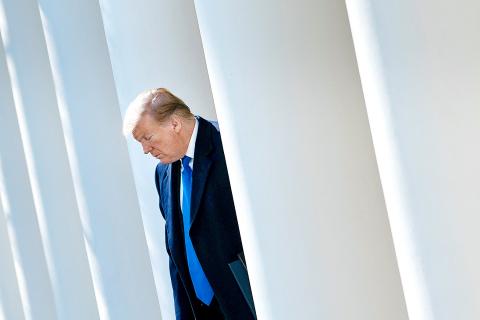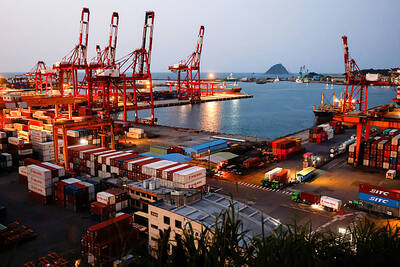US President Donald Trump on Friday declared a national emergency along the border with Mexico and predicted that his administration would end up defending it all the way to the US Supreme Court.
That might have been the only thing he said that produced near-universal agreement.
The American Civil Liberties Union announced its intention to sue less than an hour after the White House released the text of Trump’s declaration that the “current situation at the southern border presents a border security and humanitarian crisis that threatens core national security interests and constitutes a national emergency.”

Photo: AFP
Nonprofit watchdog group Public Citizen filed suit later, urging the US District Court for the District of Columbia to “bar Trump and the US Department of Defense from using the declaration and funds appropriated for other purposes to build a border wall.”
US House of Representatives Speaker Nancy Pelosi and several Democratic state attorneys general have already said that they might go to court.
The coming legal fight seems likely to hinge on two main issues: Can the US president declare a national emergency to build a border wall in the face of the US Congress’ refusal to give him all the money he wanted and, under the federal law Trump invoked in his declaration, can the department take money from some congressionally approved military construction projects to pay for wall construction?
The Pentagon has not said which projects might be affected.
However, after weeks of publicly ruminating whether to act, Trump’s signature on the declaration set in motion a quick march to the courthouse.
Trump relied on the National Emergencies Act of 1976, which Congress adopted as a way to put some limits on presidential use of national emergencies.
The act requires a US president to notify Congress publicly of the national emergency and to report every six months.
The law also says the president must renew the emergency every year, simply by notifying Congress.
The House and the US Senate can also revoke a declaration by majority vote, although it would take a two-thirds vote by each house to override an expected presidential veto.
Beyond that, the law does not say what constitutes a national emergency or impose any other limits on the president.
The broad grant of discretion to the president could make it hard to persuade courts to rule that Trump exceeded his authority in declaring a border emergency.
“He’s the one who gets to make the call. We can’t second-guess it,” said John Eastman, a professor of constitutional law at Chapman University’s School of Law.
Courts are often reluctant to look beyond the justifications the US president included in his proclamation, Ohio State University law professor Peter Shane said on a call organized by the liberal American Constitution Society.
However, other legal experts said that the facts are powerfully arrayed against the president.
They include government statistics showing a decades-long decline in illegal border crossings, as well as Trump’s rejection of a deal last year that would have provided more than the nearly US$1.4 billion he got for border security in a budget agreement he signed on Thursday.
Opponents of the declaration are also certain to use Trump’s own words at his Rose Garden news conference on Friday to argue that there is no emergency on the border.
“I could do the wall over a longer period of time,” Trump said. “I didn’t need to do this, but I’d rather do it much faster.”
US Representative Justin Amash, a Republican, said Congress made a conscious choice not to give Trump what he wanted.
“A prerequisite for declaring an emergency is that the situation requires immediate action and Congress does not have an opportunity to act,” Amash said on Twitter.

US President Donald Trump yesterday announced sweeping "reciprocal tariffs" on US trading partners, including a 32 percent tax on goods from Taiwan that is set to take effect on Wednesday. At a Rose Garden event, Trump declared a 10 percent baseline tax on imports from all countries, with the White House saying it would take effect on Saturday. Countries with larger trade surpluses with the US would face higher duties beginning on Wednesday, including Taiwan (32 percent), China (34 percent), Japan (24 percent), South Korea (25 percent), Vietnam (46 percent) and Thailand (36 percent). Canada and Mexico, the two largest US trading

China's military today said it began joint army, navy and rocket force exercises around Taiwan to "serve as a stern warning and powerful deterrent against Taiwanese independence," calling President William Lai (賴清德) a "parasite." The exercises come after Lai called Beijing a "foreign hostile force" last month. More than 10 Chinese military ships approached close to Taiwan's 24 nautical mile (44.4km) contiguous zone this morning and Taiwan sent its own warships to respond, two senior Taiwanese officials said. Taiwan has not yet detected any live fire by the Chinese military so far, one of the officials said. The drills took place after US Secretary

CHIP EXCEPTION: An official said that an exception for Taiwanese semiconductors would have a limited effect, as most are packaged in third nations before being sold The Executive Yuan yesterday decried US President Donald Trump’s 32 percent tariff on Taiwanese goods announced hours earlier as “unfair,” saying it would lodge a representation with Washington. The Cabinet in a statement described the pledged US tariffs, expected to take effect on Wednesday next week, as “deeply unreasonable” and “highly regrettable.” Cabinet spokeswoman Michelle Lee (李慧芝) said that the government would “lodge a solemn representation” with the US Trade Representative and continue negotiating with Washington to “ensure the interests of our nation and industries.” Trump at a news conference in Washington on Wednesday announced a 10 percent baseline tariff on most goods

THUGGISH BEHAVIOR: Encouraging people to report independence supporters is another intimidation tactic that threatens cross-strait peace, the state department said China setting up an online system for reporting “Taiwanese independence” advocates is an “irresponsible and reprehensible” act, a US government spokesperson said on Friday. “China’s call for private individuals to report on alleged ‘persecution or suppression’ by supposed ‘Taiwan independence henchmen and accomplices’ is irresponsible and reprehensible,” an unnamed US Department of State spokesperson told the Central News Agency in an e-mail. The move is part of Beijing’s “intimidation campaign” against Taiwan and its supporters, and is “threatening free speech around the world, destabilizing the Indo-Pacific region, and deliberately eroding the cross-strait status quo,” the spokesperson said. The Chinese Communist Party’s “threats